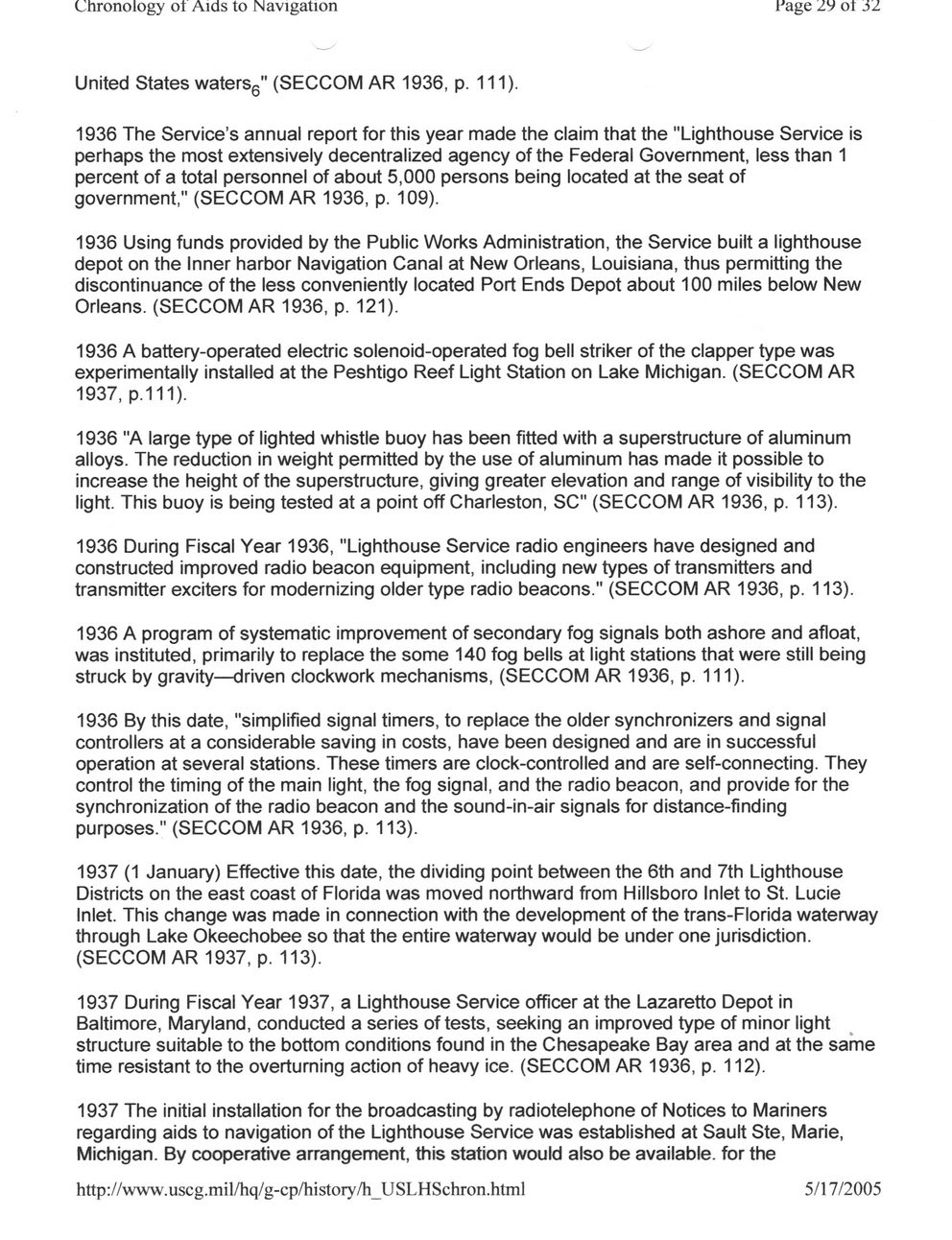This text was obtained via automated optical character recognition.
It has not been edited and may therefore contain several errors.
Chronology 01 Aids to Navigation Page 29 ot 32 United States waters6" (SECCOM AR 1936, p. 111). 1936 The Service’s annual report for this year made the claim that the "Lighthouse Service is perhaps the most extensively decentralized agency of the Federal Government, less than 1 percent of a total personnel of about 5,000 persons being located at the seat of government," (SECCOM AR 1936, p. 109). 1936 Using funds provided by the Public Works Administration, the Service built a lighthouse depot on the Inner harbor Navigation Canal at New Orleans, Louisiana, thus permitting the discontinuance of the less conveniently located Port Ends Depot about 100 miles below New Orleans. (SECCOM AR 1936, p. 121). 1936 A battery-operated electric solenoid-operated fog bell striker of the clapper type was experimentally installed at the Peshtigo Reef Light Station on Lake Michigan. (SECCOM AR 1937, p.111). 1936 "A large type of lighted whistle buoy has been fitted with a superstructure of aluminum alloys. The reduction in weight permitted by the use of aluminum has made it possible to increase the height of the superstructure, giving greater elevation and range of visibility to the light. This buoy is being tested at a point off Charleston, SC" (SECCOM AR 1936, p. 113). 1936 During Fiscal Year 1936, "Lighthouse Service radio engineers have designed and constructed improved radio beacon equipment, including new types of transmitters and transmitter exciters for modernizing older type radio beacons." (SECCOM AR 1936, p. 113). 1936 A program of systematic improvement of secondary fog signals both ashore and afloat, was instituted, primarily to replace the some 140 fog bells at light stations that were still being struck by gravity—driven clockwork mechanisms, (SECCOM AR 1936, p. 111). 1936 By this date, "simplified signal timers, to replace the older synchronizers and signal controllers at a considerable saving in costs, have been designed and are in successful operation at several stations. These timers are clock-controlled and are self-connecting. They control the timing of the main light, the fog signal, and the radio beacon, and provide for the synchronization of the radio beacon and the sound-in-air signals for distance-finding purposes." (SECCOM AR 1936, p. 113). 1937 (1 January) Effective this date, the dividing point between the 6th and 7th Lighthouse Districts on the east coast of Florida was moved northward from Hillsboro Inlet to St. Lucie Inlet. This change was made in connection with the development of the trans-Florida waterway through Lake Okeechobee so that the entire waterway would be under one jurisdiction. (SECCOM AR 1937, p. 113). 1937 During Fiscal Year 1937, a Lighthouse Service officer at the Lazaretto Depot in Baltimore, Maryland, conducted a series of tests, seeking an improved type of minor light structure suitable to the bottom conditions found in the Chesapeake Bay area and at the same time resistant to the overturning action of heavy ice. (SECCOM AR 1936, p. 112). 1937 The initial installation for the broadcasting by radiotelephone of Notices to Mariners regarding aids to navigation of the Lighthouse Service was established at Sault Ste, Marie, Michigan. By cooperative arrangement, this station would also be available, for the http://www.uscg.mil/hq/g-cp/history/h_USLHSchron.html 5/17/2005

Lighthouses Chronology-of-Aids-to-Navigation-(30)